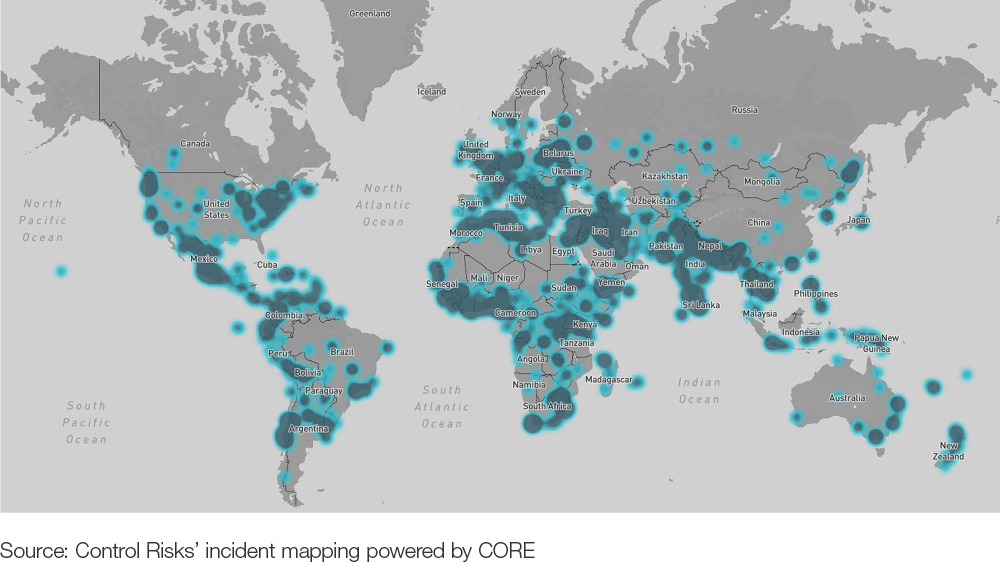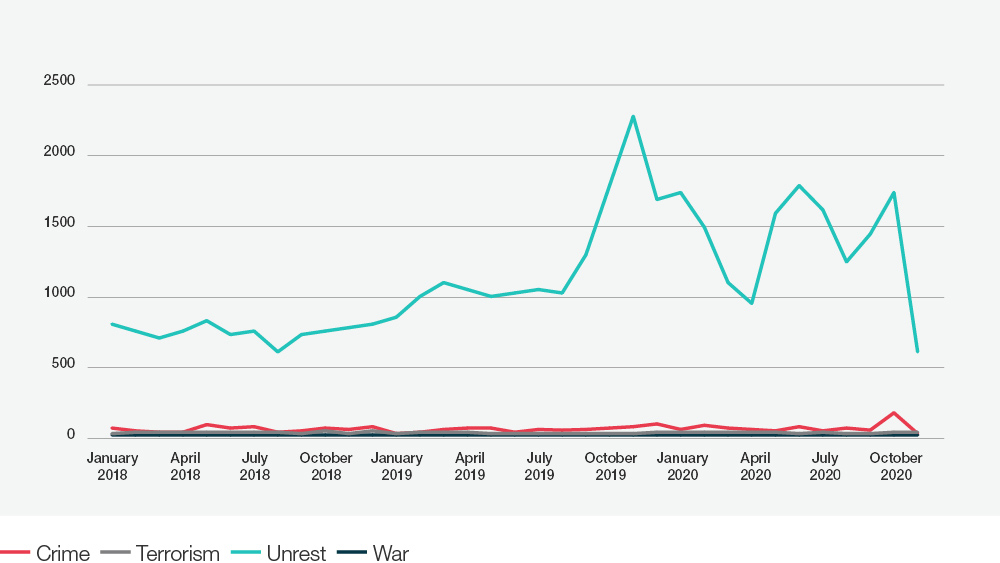Over the past year, the US has been a major focal point of unrest and disruption. That trend will continue. Yet unrest doesn’t exist in a vacuum – it’s as global as your business. In the immediate and foreseeable future, companies will face different types, frequencies and intensities of disruption in the US and across the globe. The challenge is allocating your company’s resources and attention to issues that are rapidly becoming permanent features of doing business.
Effectively managing your business’s response to unrest requires a plan of how to respond when a threat materializes, but it also means anticipating where seemingly ambient unrest will become a hotspot. Activist movements feed and take cues from each other. The perspective you already have within one operating environment, such as the US, will help you understand others.
On (mostly) familiar turf
For a while, the COVID-19 pandemic appeared to put social unrest on hold, but that didn’t last very long. After lockdowns lifted – and even during them – unrest returned to the streets. Due to the pandemic, nations, communities and constituencies are now poorer, less healthy and less trusting of their governments than they were previously, exacerbating issues already in play. More than anything else, people are just tired of the pandemic. It’s a nervous, edgy time.
The result? Every type of activism – on climate change, income inequality, refugees, and race and gender equality – is more intense. To name just a few:
- The European protest landscape is densely packed with a diverse field of left-wing and right-wing actors with serious intent and broad capability. There is hardly a major European capital city that has not been seriously disrupted by protests, some of them violent. A second wave of pandemic-related restrictions and a stuttering economic recovery in 2021 keeps the atmosphere feverish.
- Disruptive demonstrations, some with the potential for violence, are possible in the coming months in Hong Kong, though the implementation of the national security law will dampen their severity. In Thailand, significantly diluted democratic rights, coupled with growing public discontent over the palace and the military’s persistent interference in politics, are likely to sustain anti-government sentiment and sporadic protests. Civil unrest risks remain elevated in India, too.
- Lower- or middle-income countries with young populations, whether suffering from low oil prices or falling remittances, from the Middle East to South America, have been and will
remain acutely vulnerable to civil unrest.


Same threat, new challenges
While the reasons for and manifestations of unrest may not have changed much, the environment in which your organization operates is different. Many employees are now at home, rather than sitting on upper floors in skyscrapers or behind access-controlled, magnetic doors. Some may feel safer; others may feel more vulnerable. Extending your company’s duty of care to people working at home presents a new set of challenges.
The expectations of your stakeholders are likely to have changed as well; employees, clients and shareholders will have certain expectations regarding your response to unrest, both in terms of messaging and actions. What do you tell your employees if there’s a climate protest in the center of London and they want to join? How do you best respond when stakeholders expect you to show support for certain norms or values?
Use the right lens; use many lenses
Managing these different challenges requires looking at the macro and micro operating environments simultaneously and using a multi-disciplinary lens. This is not an issue solely owned by the security and risk function – it should involve human resources, communications, legal, HSE and wider business stakeholders.
Between these stakeholders, agree on some broad lines of engagement for your organization: Are you responsible for protecting employees’ homes and families if they’re working from home? How will you protect employees who participate in protests? How do you want your security guards to act in the case of unrest? How will you message these commitments to your wider stakeholders?
Continuous monitoring will flag the next hotspots. If a situation arises, focus on key locations and assets with precision to identify local issues requiring immediate attention. Link your monitoring activities firmly to the contingency, resilience and security operations across your company. This will sometimes include boots-on-the-ground security support.
If you haven’t linked your protest monitoring to your crisis and continuity processes, your decision-making and action plans will be several steps behind . COVID-19 has brought most companies into this new practice. If you aren’t there now, you should be.
Here are five key issues every company should consider when approaching risks arising from social unrest:
- Take a step back. Objectively assess your risk management programs and longer-term security needs. Do they enable critical revenue-generation activities? Just as importantly, do they align with how your post-pandemic business will look? It isn’t practical or cost effective to sit in a perpetual cycle of intensive crisis response and reactive decision-making. Data is key to helping drive program alignment and optimization
- Evaluate crisis management team membership and bandwidth. Expand as needed to handle multiple crises and guard against fatigue or burnout. Ensure your global crisis management program is structured to empower local teams with the authority to take decisions and action to manage incidents in real time.
- Define your social and community engagement agenda. Work closely with communications and human resources. Bring your CSR team into the fold. This is as much about employee engagement and talent retention as it is about managing reputational issues.
- Refocus your government relations program and approach to political risk management. Your host government may not be pleased if your employees are protesting in the streets.
- Challenge previous thinking on duty of care and revisit associated policies. The needle has moved on what can be described as “reasonably foreseeable”; so have the associated employee expectations.
And what actions should you be taking to prepare? Here are five steps companies can take to prepare for social unrest wherever it occurs:
1. Identify best case, worst case and most likely scenarios and begin monitoring against them, using internal and external data sources, mapped against your key assets and operations, to drive prioritization and focus.
2. Build a set of indicators that are sensitive to changes in the environment where you do business, including employee sentiment. Track them, measure them, and periodically benchmark them to make sure they remain relevant. Ensure you have the resources and capacity to do this.
3. Develop a high-level communications strategy that addresses the types of communications you need, the audiences and stakeholders to target; determine how often, through which channels and by whom. This should tie in with an updated stakeholder analysis exercise.
4. Test your emergency alert or mass notification tools to ensure they can be effectively leveraged should violent unrest break out near your key locations and assets and that you can account for staff.
5. Provide guidance, training and ongoing reminders to employees about:
a. Your code of conduct, media/social media/communication and company equipment policies. These policies will guide your colleagues’ behavior in a crisis.
b. Resources available for support (EAP, company intranet, etc).
c. The issues to escalate, who to escalate to and who to escalate from.
d. What to do if employees find themselves in a threatening situation.
e. How you will communicate with employees regarding violent unrest.
